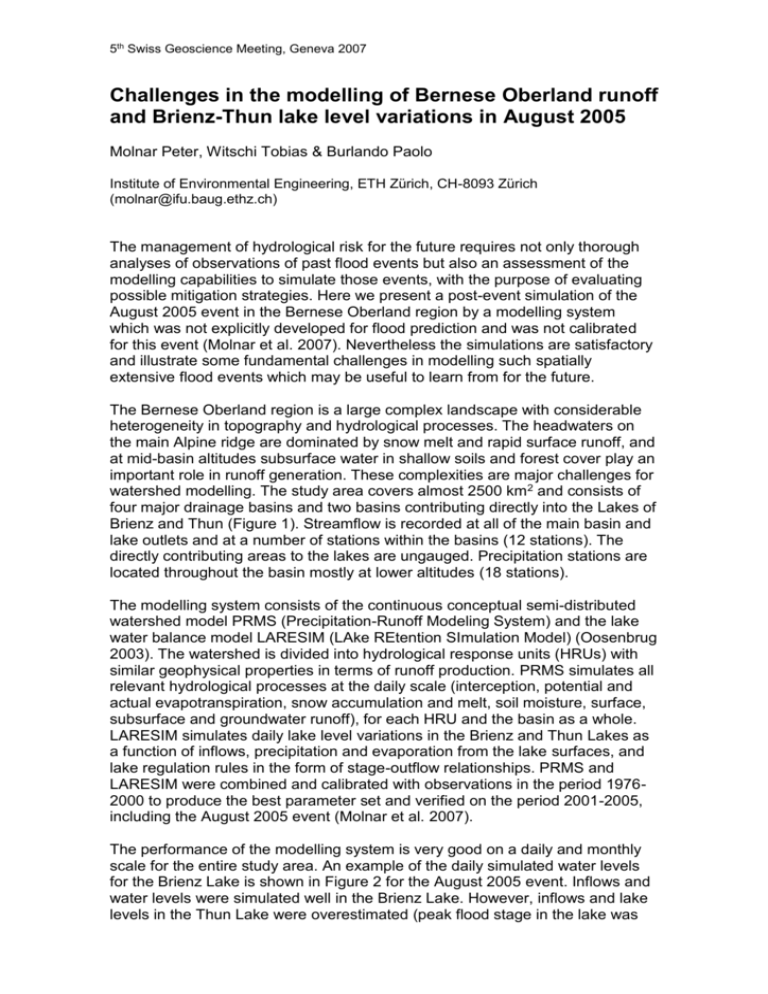Molnar_Peter_Talk - SWISS GEOSCIENCE MEETINGs
advertisement

5th Swiss Geoscience Meeting, Geneva 2007 Challenges in the modelling of Bernese Oberland runoff and Brienz-Thun lake level variations in August 2005 Molnar Peter, Witschi Tobias & Burlando Paolo Institute of Environmental Engineering, ETH Zürich, CH-8093 Zürich (molnar@ifu.baug.ethz.ch) The management of hydrological risk for the future requires not only thorough analyses of observations of past flood events but also an assessment of the modelling capabilities to simulate those events, with the purpose of evaluating possible mitigation strategies. Here we present a post-event simulation of the August 2005 event in the Bernese Oberland region by a modelling system which was not explicitly developed for flood prediction and was not calibrated for this event (Molnar et al. 2007). Nevertheless the simulations are satisfactory and illustrate some fundamental challenges in modelling such spatially extensive flood events which may be useful to learn from for the future. The Bernese Oberland region is a large complex landscape with considerable heterogeneity in topography and hydrological processes. The headwaters on the main Alpine ridge are dominated by snow melt and rapid surface runoff, and at mid-basin altitudes subsurface water in shallow soils and forest cover play an important role in runoff generation. These complexities are major challenges for watershed modelling. The study area covers almost 2500 km 2 and consists of four major drainage basins and two basins contributing directly into the Lakes of Brienz and Thun (Figure 1). Streamflow is recorded at all of the main basin and lake outlets and at a number of stations within the basins (12 stations). The directly contributing areas to the lakes are ungauged. Precipitation stations are located throughout the basin mostly at lower altitudes (18 stations). The modelling system consists of the continuous conceptual semi-distributed watershed model PRMS (Precipitation-Runoff Modeling System) and the lake water balance model LARESIM (LAke REtention SImulation Model) (Oosenbrug 2003). The watershed is divided into hydrological response units (HRUs) with similar geophysical properties in terms of runoff production. PRMS simulates all relevant hydrological processes at the daily scale (interception, potential and actual evapotranspiration, snow accumulation and melt, soil moisture, surface, subsurface and groundwater runoff), for each HRU and the basin as a whole. LARESIM simulates daily lake level variations in the Brienz and Thun Lakes as a function of inflows, precipitation and evaporation from the lake surfaces, and lake regulation rules in the form of stage-outflow relationships. PRMS and LARESIM were combined and calibrated with observations in the period 19762000 to produce the best parameter set and verified on the period 2001-2005, including the August 2005 event (Molnar et al. 2007). The performance of the modelling system is very good on a daily and monthly scale for the entire study area. An example of the daily simulated water levels for the Brienz Lake is shown in Figure 2 for the August 2005 event. Inflows and water levels were simulated well in the Brienz Lake. However, inflows and lake levels in the Thun Lake were overestimated (peak flood stage in the lake was 5th Swiss Geoscience Meeting, Geneva 2007 about 50 cm higher than observed). In this paper we illustrate what we think were the reasons for the over-estimation: a) unknown contributions to the lake from direct basin drainage; b) incorrect input of precipitation on the lake surface; and c) departure of actual lake outflows from the regulation rule. In particular, Meteoswiss radar data for the event are used to show that an incorrect assessment of the spatial distribution of rainfall may have led to substantial errors in runoff and water level predictions at this spatial scale. Figure 1. Location of the study area, 4 study basins and 2 directly contributing basins draining into the Brienz and Thun Lakes. 568 0 567 40 60 566 80 100 565 Hsim Hobs 120 140 564 160 180 563 01.05.05 200 01.06.05 01.07.05 01.08.05 01.09.05 Figure 2. Daily observed and simulated water levels and estimated precipitation on the lake surface from 1 May - 31 September 2005 for the Lake of Brienz. REFERENCES Molnar, P., Witschi, T., Burlando, P., Oosenbrug, E. & Ruf, W. 2007: Evaluating potential impacts of climate change on floods and water levels in an Alpine lake system in Switzerland, Hydrology and Earth System Sciences, in preparation. Oosenbrug, E. 2003: Einzugsgebiets- und Seeretentionsmodellierung im Berner Oberland: Hochwassersimulation durch Kopplung zweier Modelle, M.S. Thesis, ETH Zürich, 112pp. PRECIPITATION (mm) WATER LEVEL (m) 20








